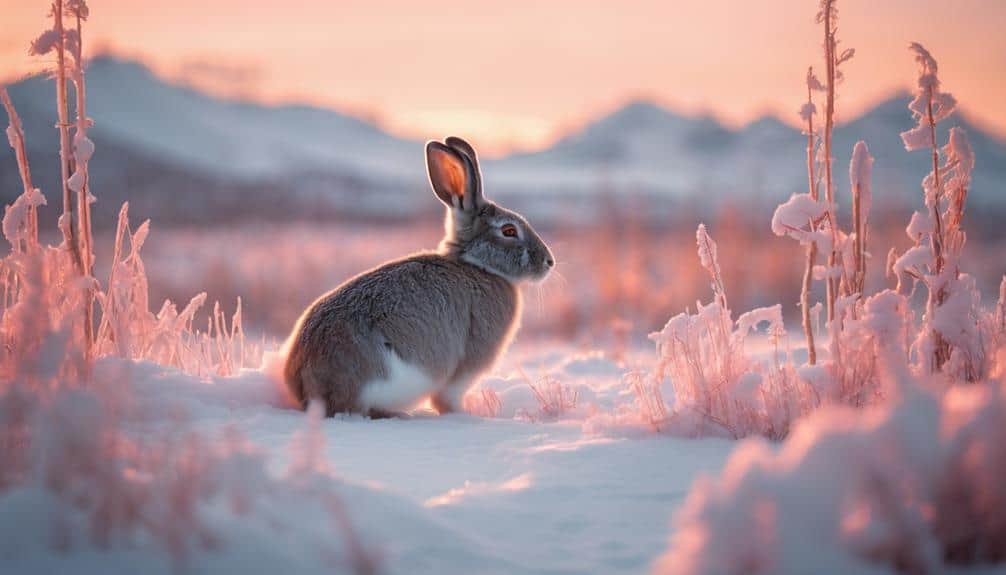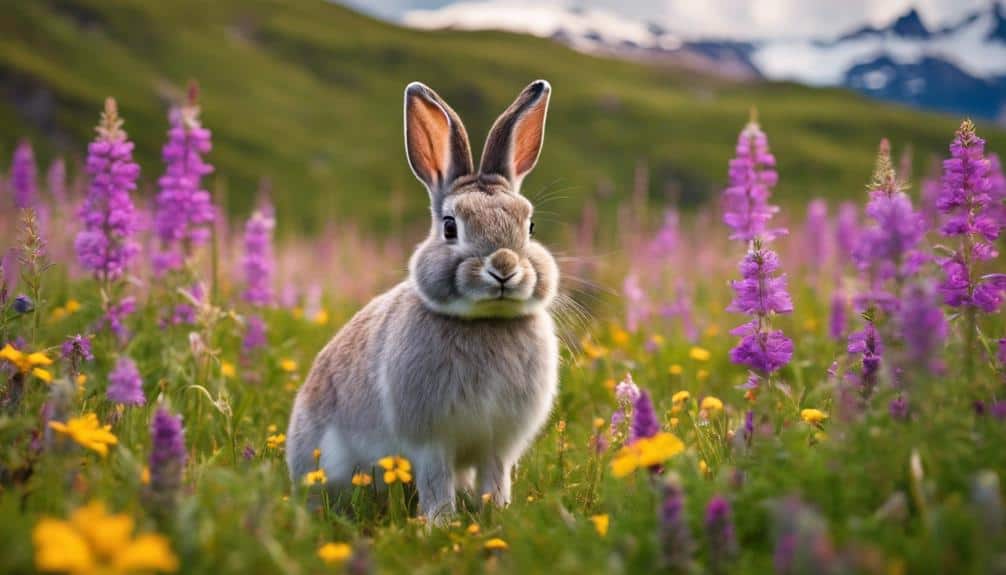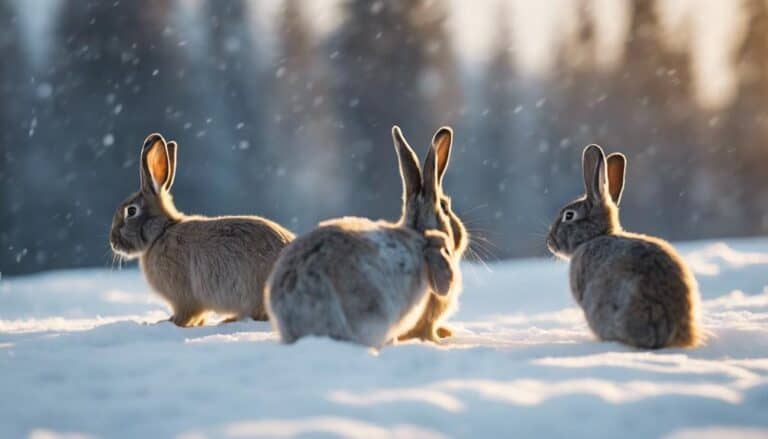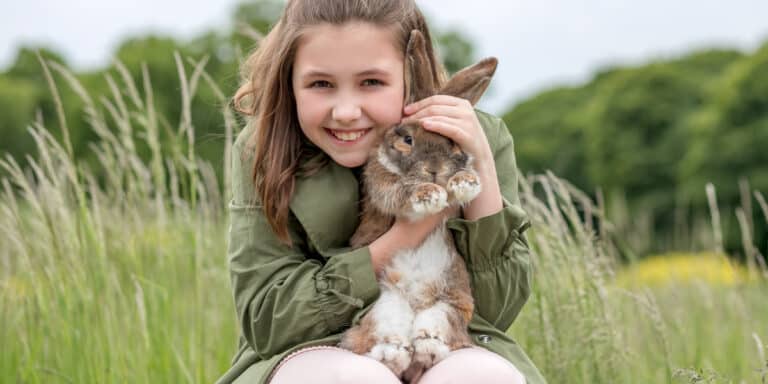To spot wild bunnies in Alaska, explore diverse habitats like forests and meadows, seeking signs such as tracks and nibbled vegetation. Learn their behavior by recognizing tracks, observing feeding habits, and understanding predator-prey dynamics. Best spotting times are early morning and late evening, with clear weather enhancing chances. Identify bunny tracks by size, visibility, and paw print details. Patience is key for successful sightings, respecting wildlife and minimizing disturbances. Gear up with binoculars, weatherproof clothing, and a field guide for better spotting. Remember, a deeper understanding leads to more rewarding encounters with these elusive creatures.
Contents
- 1 Key Takeaways
- 2 Bunny Habitats in Alaska
- 3 Understanding Bunny Behavior
- 4 Best Time of Day for Spotting
- 5 Identifying Bunny Tracks
- 6 Importance of Patience in Spotting
- 7 Proper Gear for Bunny Watching
- 8 Avoiding Disturbing Bunny Habitats
- 9 Tips for Photographing Wild Bunnies
- 10 Respecting Bunny Conservation Efforts
- 11 How Can Understanding Alaskan Bunny Behavior Help in Spotting Them in the Wild?
- 12 Conclusion
Key Takeaways
- Understand bunny habitats in Alaska for locating them effectively.
- Recognize tracks and feeding habits to enhance spotting chances.
- Optimal spotting times: early morning and late evening for active bunnies.
- Identify bunny tracks by size, visibility, and paw print details.
- Exercise patience, respect wildlife, and use proper gear for successful spotting.
Bunny Habitats in Alaska

In Alaska, wild bunnies establish their habitats in diverse environments, including forests, meadows, and tundra regions. These habitats provide a range of food sources for the bunnies, such as grass, flowers, and various plants. Understanding their habitat preferences is key to spotting these elusive creatures in the Alaskan wilderness.
Wild bunnies in Alaska tend to seek shelter in burrows, brush piles, and thick vegetation to protect themselves from predators. In urban areas, they may also take refuge in parks and gardens while feeding on grass, flowers, and garden plants. To increase your chances of spotting wild bunnies, look for signs like tracks, droppings, and nibbled vegetation that indicate their presence in an area.
Understanding Bunny Behavior
Wild bunnies in Alaska, particularly snowshoe hares, exhibit distinct behavioral patterns influenced by their need for camouflage in their diverse habitats to evade predators. Understanding bunny behavior is essential when trying to spot these elusive creatures.
Here are some tips to help you make the most of your bunny-watching experience:
- Recognize Tracks: Pay attention to the tracks left by wild rabbits as they can lead you to their hiding spots.
- Observe Feeding Habits: Wild rabbits are herbivores; spotting areas with fresh vegetation can increase your chances of encountering them.
- Preferred Habitats: Look for snowshoe hares in dense brush, near shrubs, or in areas with low-hanging branches where they can hide.
- Predator-Prey Dynamics: Understanding how rabbits interact with their predators can help you anticipate their movements and increase your chances of a sighting.
Make sure to take advantage of these insights to enhance your encounters with wild rabbits in the Alaskan wilderness.
Best Time of Day for Spotting

Spotting wild bunnies in Alaska is most effective during the early morning and late evening hours when they are most active. During these times, bunnies are more likely to be out foraging for food, making it easier to observe them in their natural habitat. The quiet and cooler temperatures of dawn and dusk provide ideal conditions for bunny watching, as they feel more comfortable and secure moving around. This is also the best time for photographers to capture stunning images of these elusive creatures.
To increase your chances of spotting wild bunnies in Alaska, understanding their behavior, including feeding habits, mating season, and predators and threats they face, is crucial. Here is a table summarizing these key points:
| Aspect | Details |
|---|---|
| Bunny feeding habits | Bunnies are crepuscular feeders, most active at dawn & dusk. |
| Bunny mating season | Mating season typically occurs in spring and summer. |
| Bunny predators | Predators include foxes, birds of prey, and domestic pets. |
| Bunny threats | Loss of habitat, climate change, and hunting are threats. |
Identifying Bunny Tracks
When identifying bunny tracks, observe their smaller and delicate nature compared to larger animal tracks. Look for four paw prints close together, forming a 'double set' pattern, possibly showing claw marks in soft or muddy ground.
The distinctive longer hind feet of bunnies leave tracks that may display a hopping pattern with larger gaps when running.
Track Size Comparison
To distinguish bunny tracks from other wildlife imprints, observe their smaller and more delicate nature, noting the distinctive size difference between their front and hind feet. When comparing bunny tracks in snow versus mud, consider the depth and clarity of the imprints.
Environmental conditions like snow quality and mud consistency can affect track visibility. Track size variability can indicate the age differences or size of the bunny, offering valuable insights for identification purposes.
Understanding these nuances in track sizes can aid in tracking bunny movements and gaining a better understanding of their habitat preferences. Remember to look for four toes on the front feet and five toes on the larger hind feet to confirm you're following bunny tracks.
Paw Print Details
Inspecting the intricacies of bunny paw prints reveals key identifiers essential for accurate tracking and identification purposes. Bunny tracks typically display four toes in the front and one in the back, resembling a small handprint. The hind feet are larger and longer, providing stability and propulsion.
Look for tracks in soft soil, mud, or snow with distinct imprints, indicating recent bunny activity. The spacing between tracks is due to their hopping motion, with front feet landing first followed by the hind feet.
Scat Identification
Examining bunny scat serves as an essential method in identifying their presence and activity within a specific area. When analyzing bunny scat, consider the following:
- Bunny scat is small, round, and pellet-like, resembling a miniature version of deer droppings.
- The size of bunny scat is typically around 1/4 inch in diameter, making it distinguishable from other animal droppings.
- Bunny tracks may accompany scat, featuring two larger hind feet impressions in front and two smaller front feet impressions behind.
- Identifying fresh bunny scat can indicate recent bunny activity in the area, aiding in tracking and spotting them.
Through careful scat analysis, wildlife signs, and field observations, you can enhance your ability to spot wild bunnies in their natural habitat.
Importance of Patience in Spotting
Patiently observing wild bunnies in Alaska is essential for successfully spotting them in their natural habitat. Wild bunnies, known for their elusive nature, require a calm and patient approach to increase the chances of a sighting. By taking the time to quietly observe their natural behavior and surroundings, you can appreciate the beauty and grace of these creatures. Avoid sudden movements or loud noises, as wild bunnies are sensitive to disturbances and may quickly retreat. Understanding the environments where bunnies are commonly found, such as grassy lawns or under sheds, can aid in patient observation. This patience not only enhances your chances of spotting them but also contributes to wildlife conservation efforts by respecting their natural behaviors.
| Importance of Patience in Spotting Wild Bunnies | |
|---|---|
| Observation techniques, wildlife photography | Increase chances of successful spotting |
| Wildlife conservation, animal behavior | Respect natural behaviors |
| Nature appreciation, outdoor exploration | Enhance overall experience |
Proper Gear for Bunny Watching

To enhance your chances of successfully spotting wild bunnies in Alaska, equip yourself with the appropriate gear for bunny watching, starting with binoculars featuring a magnification range of 8x to 10x. Here are some essential items to contemplate:
- Binocular maintenance: Keep your binoculars clean and in good condition to guarantee clear viewing.
- Weatherproof clothing: Dress in layers and wear waterproof clothing to stay comfortable during varying weather conditions.
- Photography techniques: Use a camera with a zoom lens to capture detailed shots of wild bunnies without disturbing them.
- Camouflage gear: Ponder using camouflage clothing or a blind to blend into your surroundings and observe bunnies discreetly.
Additionally, carrying a field guide on local rabbit species and their habitats can provide valuable insights for better wildlife observation. By being well-prepared with the right gear and knowledge, you can maximize your bunny watching experience while respecting the natural habitat of these adorable creatures.
Avoiding Disturbing Bunny Habitats
When observing wild bunnies, remember to respect their nesting areas and stick to designated paths to avoid disturbing their habitats.
By staying on trails, you can prevent unintentional trampling and safeguard the sensitive ecosystems where bunnies reside.
Being mindful of your surroundings and minimizing human impact will guarantee a harmonious coexistence with these adorable creatures in their natural environment.
Respect Nesting Areas
Avoid walking through tall grass or underbrush where bunnies may have their nests to prevent disturbing their habitats. When exploring bunny habitats, it's important to respect nesting areas to guarantee the safety and well-being of these creatures.
To help you navigate this delicate balance, here are some tips to keep in mind:
- Look for signs of bunnies like tracks, droppings, or chewed vegetation to identify their nesting areas.
- Keep a safe distance from bunny nests to prevent disturbing mothers and their young.
- Be aware of areas where bunnies commonly build their nests, such as under bushes, in tall grass, or in burrows.
- Respect wildlife by observing bunnies from a distance and appreciating their natural habitat.
Stay on Designated Paths
By sticking to designated paths, you can minimize human impact on wild bunny habitats and observe these creatures from a safe distance. Trail etiquette plays an essential role in wildlife observation and habitat preservation. Walking off trails can trample vegetation that bunnies rely on for food and shelter, disrupting their natural habitat. This disturbance can lead to changes in bunny behavior, affecting their survival and overall well-being.
Conservation awareness is key to understanding the importance of staying on designated paths to protect the delicate balance of the ecosystem. By respecting these pathways, you contribute to the ecosystem's harmony and guarantee the continued presence of wild bunnies in their natural surroundings. Stay mindful of your surroundings and help maintain ecosystem balance by following designated paths.
Tips for Photographing Wild Bunnies

For best results in capturing striking photographs of wild bunnies, consider utilizing a telephoto lens to maintain a respectful distance while still achieving close-up imagery. When photographing these elusive creatures, remember to employ the following bunny photography techniques, wildlife observation tips, and nature photography skills:
- Use a telephoto lens: This allows you to get detailed shots without encroaching on the bunny's space.
- Timing is key: Seek out bunnies during the early morning or late afternoon for softer lighting conditions that enhance your photos.
- Get down to their level: To create more engaging shots, crouch down to the bunny's eye level for a personal touch.
- Move slowly and avoid sudden gestures: Gain the trust of the wild bunnies by approaching them calmly and steadily.
Respecting Bunny Conservation Efforts
Supporting the conservation efforts for wild bunnies in Alaska is essential for preserving their natural habitats and ensuring their long-term survival. Conservation ethics play a vital role in maintaining the delicate balance of ecosystems that these bunnies rely on for food, shelter, and safety. Habitat preservation is key to safeguarding the diverse flora and fauna that coexist with these adorable creatures. By respecting bunny conservation, you contribute to the broader wildlife awareness and promote a harmonious relationship between humans and nature.
| Conservation Ethics | Habitat Preservation | Wildlife Awareness |
|---|---|---|
| Avoiding disruptions to bunny environments | Protecting natural habitats | Learning about specific bunny species |
| Following designated trails | Ensuring long-term survival | Contributing to local wildlife organizations |
| Respecting nesting areas | Reducing human impact | Volunteering for conservation projects |
How Can Understanding Alaskan Bunny Behavior Help in Spotting Them in the Wild?
Understanding alaskan bunny behavior patterns is crucial in spotting them in the wild. By learning their habits and movements, you can anticipate their actions and increase your chances of encountering them. Paying attention to their behavior can also provide insight into their preferred habitats and help you locate them more effectively.
Conclusion
Congratulations, you have now mastered the art of spotting wild bunnies in Alaska!
Remember, patience is key when observing these elusive creatures in their natural habitats. Equip yourself with the proper gear and approach with respect to guarantee a successful bunny watching experience.
Always be mindful of conservation efforts and the importance of preserving these adorable creatures for future generations to enjoy.
Happy bunny spotting!






